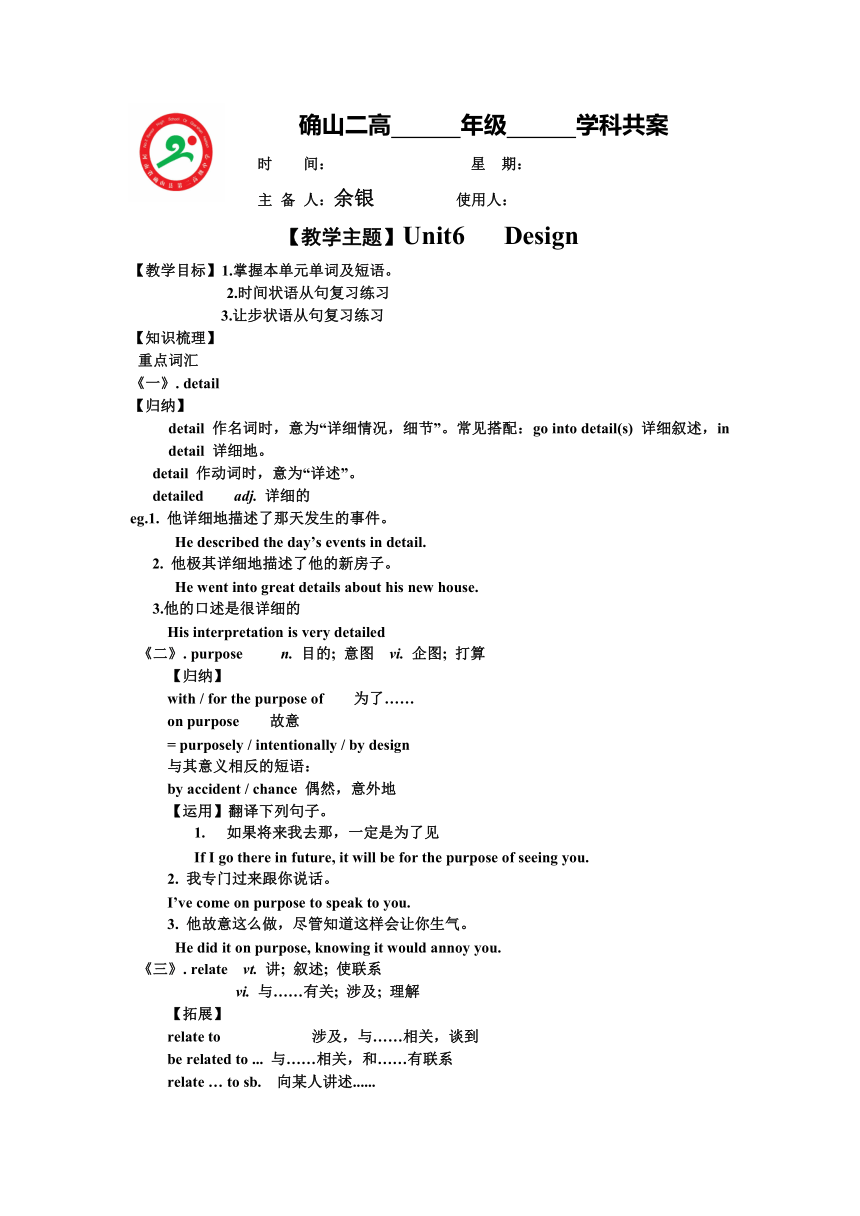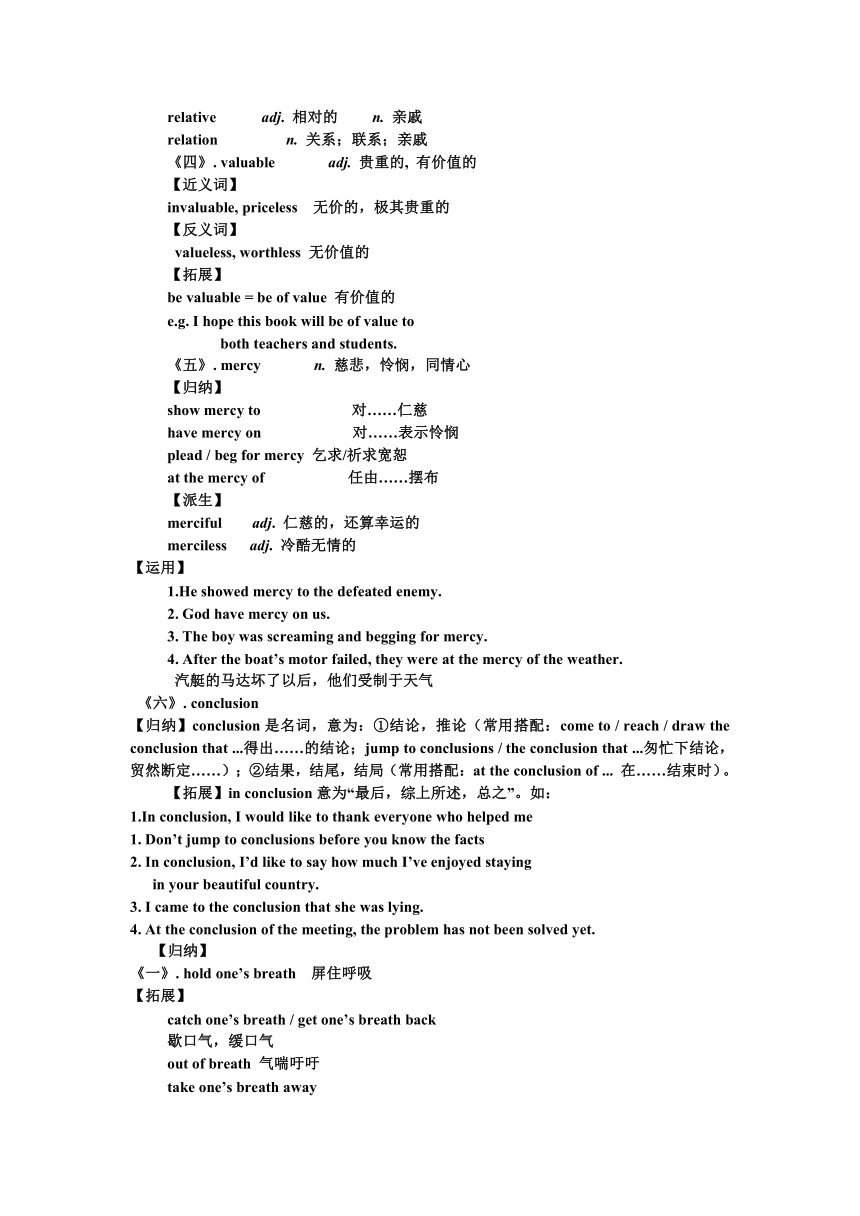河南省确山县第二高级中学2016届高三英语一轮复习教学案:Uint 6 Design
文档属性
| 名称 | 河南省确山县第二高级中学2016届高三英语一轮复习教学案:Uint 6 Design |  | |
| 格式 | zip | ||
| 文件大小 | 60.5KB | ||
| 资源类型 | 教案 | ||
| 版本资源 | 北师大版 | ||
| 科目 | 英语 | ||
| 更新时间 | 2015-11-22 09:57:31 | ||
图片预览


文档简介
确山二高 年级 学科共案
时 间: 星 期:
主 备 人:余银 使用人:
【教学主题】Unit6 Design
【教学目标】1.掌握本单元单词及短语。
2.时间状语从句复习练习
3.让步状语从句复习练习
【知识梳理】
重点词汇
《一》. detail
【归纳】
detail 作名词时,意为“详细情况,细节”。常见搭配:go into detail(s) 详细叙述,in detail 详细地。
detail 作动词时,意为“详述”。
detailed adj. 详细的
eg.1. 他详细地描述了那天发生的事件。
He described the day’s events in detail.
2. 他极其详细地描述了他的新房子。
He went into great details about his new house.
3.他的口述是很详细的
His interpretation is very detailed
《二》. purpose n. 目的; 意图 vi. 企图; 打算
【归纳】
with / for the purpose of 为了……
on purpose 故意
= purposely / intentionally / by design
与其意义相反的短语:
by accident / chance 偶然,意外地
【运用】翻译下列句子。
如果将来我去那,一定是为了见
If I go there in future, it will be for the purpose of seeing you.
2. 我专门过来跟你说话。
I’ve come on purpose to speak to you.
3. 他故意这么做,尽管知道这样会让你生气。
He did it on purpose, knowing it would annoy you.
《三》. relate vt. 讲; 叙述; 使联系
vi. 与……有关; 涉及; 理解
【拓展】
relate to 涉及,与……相关,谈到
be related to ... 与……相关,和……有联系
relate … to sb. 向某人讲述......
relative adj. 相对的 n. 亲戚
relation n. 关系;联系;亲戚
《四》. valuable adj. 贵重的, 有价值的
【近义词】
invaluable, priceless 无价的,极其贵重的
【反义词】
valueless, worthless 无价值的
【拓展】
be valuable = be of value 有价值的
e.g. I hope this book will be of value to
both teachers and students.
《五》. mercy n. 慈悲,怜悯,同情心
【归纳】
show mercy to 对……仁慈
have mercy on 对……表示怜悯
plead / beg for mercy 乞求/祈求宽恕
at the mercy of 任由……摆布
【派生】
merciful adj. 仁慈的,还算幸运的
merciless adj. 冷酷无情的
【运用】
1.He showed mercy to the defeated enemy.
2. God have mercy on us.
3. The boy was screaming and begging for mercy.
4. After the boat’s ( http: / / www.21cnjy.com )motor failed, they were at the mercy of the weather.
汽艇的马达坏了以后,他们受制于天气
《六》. conclusion
【归纳】conclusion是名词,意为: ( http: / / www.21cnjy.com )①结论,推论(常用搭配:come to / reach / draw the conclusion that ...得出……的结论;jump to conclusions / the conclusion that ...匆忙下结论,贸然断定……);②结果,结尾,结局(常用搭配:at the conclusion of ... 在……结束时)。
【拓展】in conclusion意为“最后,综上所述,总之”。如:
1.In conclusion, I would like to thank everyone who helped me
1. Don’t jump to conclusions before you know the facts
2. In conclusion, I’d like to say how much I’ve enjoyed staying
in your beautiful country.
3. I came to the conclusion that she was lying.
4. At the conclusion ( http: / / www.21cnjy.com )of the meeting, the problem has not been solved yet.
【归纳】
《一》. hold one’s breath 屏住呼吸
【拓展】
catch one’s breath / get one’s breath back
歇口气,缓口气
out of breath 气喘吁吁
take one’s breath away
令人惊叹,让人叹绝
Eg. 1.The rac ( http: / / www.21cnjy.com )e was so close that everyone was holding his breath at the finish.
2.After running to the bus stop, we sat down to catch our breath.
3.My first view of the island from the air took my breath away.
《二》. fix one’s eyes on 注视,凝视
【拓展】 fix up
修理,装饰,准备好
fix one’s attention on
把注意力集中在……上
fix on(经过考虑后)确定,选定
eg.1. He fixed his attention on the news.
2. The young man fixed his eyes on the distant train
3. They fixed up the house before they moved in.
4. They’ve fixed on Bruce as the new chairman.
《三》. try out 试验,试用
【拓展】
try out for 参加……的选拔
try on 试穿(衣服)
try to do/doing
eg . 1. I went to the tailor’s to try on my new suit.
2. I’ll try it out and see whether it works.
3. Sherry will try out for the lead in the play.
《四》. add ... to ... 把……加到……
【归纳】add in 把……包括在内
add up 把……加起来
add up to 合计达,结果是
add to (= increase) 增添, 增加
add up 把……加起来
add up to 总计……
add that ... 接着说, 补充说
《五》. date back to / date from 追溯(到),始于
【运用】1. The church dates from / back to the 6th
century and it is ( http: / / www.21cnjy.com )one of the main tourist attractions of the city.
2. Their friendship dates from / back to their high school days.
【语法复习专练】
一.用适当的介词填空。
1. The kids are learning about the Civil War
___ their history class ___ school.
2. I have been sitting here ____ more than an
hour. If they ( http: / / www.21cnjy.com ) don’t arrive ____ the next ten minutes, I’m leaving.
3. They walked ________ the river looking for a
way to get ________ it, but there was no bridge.
4. We reached there __ 2 o’clock ___ the afternoon of October 10.
5. Lily came ____ the store, but didn’t find
what she wanted. Then she went _____ it.
二从括号内选出正确的选项填空。
1. As a child, Jerry studied in a village school
________ (which / whose) is named after his grandfather.
2. Children who are not active or ________ (who
/ whose) diet is high in fat will gain weight quickly.
3. Stephen, ________ (who / whom) has a lot of
teaching experience, will join us in the activity.
4. The settlement is home to nearly 1,000 people,
many of ________ (whom / which) left their
village homes for a better life in the city.
5. It is one of the most beautiful mountains in
China ________ (which / that) I’ve ever visited
【写作指导】
介绍建筑物类的文章属于说明文范畴。写作时,我们要注意以下几个方面:
1. 结构安排
介绍建筑物时一般采用三段式。第一段点题,点出要介绍的建筑物;第二段推展,即具体介绍或描述建筑物;第三段结尾,对所介绍的建筑物进行总结。
2. 内容概要
介绍建筑物时,主要内容应该包括该建筑物的具体位置、面积、修建的背景或年代、外观、构造、所使用的材料或用途等。
3. 写作顺序
介绍建筑物应遵循一定的空间顺序,即由宏观到微观,由外部到内部,由总体到局部。有时也可以按照修建的时间顺序来进行介绍。
4. 语言应用
介绍建筑物的语言要科学、严密、简洁明了。通常使用一般现在时、一般过去时等,也常用到被动语态、比喻等修辞手法。
【常用表达】
★表示方位 It is located in / to ...
It stands in / at / on ...
It is in / to the east / west / south / north of ...
It is on the left / right side of ...
It is opposite ...
★表示年代
It was built in the 1930s / the middle of last century ...
It has a history of ...
It dates back to ...
★表示面积It covers ...
It’s very large with an area of ...
★表示建筑材料
It is built / mad ( http: / / www.21cnjy.com )e of stone / wood / brick / glass / steel / concrete / marble ...
---------------------------------------------------------------------------------------------------------------------------------------------------------------------------------------------------------------------------------------------------------------------------------------------------------------------------------------------------------------------------------------------------------------------------------------------------------------------------------------------------------------------------------------------------------------------------------------------------------------------------------------------------------------------------------------------------------------------------
时 间: 星 期:
主 备 人:余银 使用人:
【教学主题】Unit6 Design
【教学目标】1.掌握本单元单词及短语。
2.时间状语从句复习练习
3.让步状语从句复习练习
【知识梳理】
重点词汇
《一》. detail
【归纳】
detail 作名词时,意为“详细情况,细节”。常见搭配:go into detail(s) 详细叙述,in detail 详细地。
detail 作动词时,意为“详述”。
detailed adj. 详细的
eg.1. 他详细地描述了那天发生的事件。
He described the day’s events in detail.
2. 他极其详细地描述了他的新房子。
He went into great details about his new house.
3.他的口述是很详细的
His interpretation is very detailed
《二》. purpose n. 目的; 意图 vi. 企图; 打算
【归纳】
with / for the purpose of 为了……
on purpose 故意
= purposely / intentionally / by design
与其意义相反的短语:
by accident / chance 偶然,意外地
【运用】翻译下列句子。
如果将来我去那,一定是为了见
If I go there in future, it will be for the purpose of seeing you.
2. 我专门过来跟你说话。
I’ve come on purpose to speak to you.
3. 他故意这么做,尽管知道这样会让你生气。
He did it on purpose, knowing it would annoy you.
《三》. relate vt. 讲; 叙述; 使联系
vi. 与……有关; 涉及; 理解
【拓展】
relate to 涉及,与……相关,谈到
be related to ... 与……相关,和……有联系
relate … to sb. 向某人讲述......
relative adj. 相对的 n. 亲戚
relation n. 关系;联系;亲戚
《四》. valuable adj. 贵重的, 有价值的
【近义词】
invaluable, priceless 无价的,极其贵重的
【反义词】
valueless, worthless 无价值的
【拓展】
be valuable = be of value 有价值的
e.g. I hope this book will be of value to
both teachers and students.
《五》. mercy n. 慈悲,怜悯,同情心
【归纳】
show mercy to 对……仁慈
have mercy on 对……表示怜悯
plead / beg for mercy 乞求/祈求宽恕
at the mercy of 任由……摆布
【派生】
merciful adj. 仁慈的,还算幸运的
merciless adj. 冷酷无情的
【运用】
1.He showed mercy to the defeated enemy.
2. God have mercy on us.
3. The boy was screaming and begging for mercy.
4. After the boat’s ( http: / / www.21cnjy.com )motor failed, they were at the mercy of the weather.
汽艇的马达坏了以后,他们受制于天气
《六》. conclusion
【归纳】conclusion是名词,意为: ( http: / / www.21cnjy.com )①结论,推论(常用搭配:come to / reach / draw the conclusion that ...得出……的结论;jump to conclusions / the conclusion that ...匆忙下结论,贸然断定……);②结果,结尾,结局(常用搭配:at the conclusion of ... 在……结束时)。
【拓展】in conclusion意为“最后,综上所述,总之”。如:
1.In conclusion, I would like to thank everyone who helped me
1. Don’t jump to conclusions before you know the facts
2. In conclusion, I’d like to say how much I’ve enjoyed staying
in your beautiful country.
3. I came to the conclusion that she was lying.
4. At the conclusion ( http: / / www.21cnjy.com )of the meeting, the problem has not been solved yet.
【归纳】
《一》. hold one’s breath 屏住呼吸
【拓展】
catch one’s breath / get one’s breath back
歇口气,缓口气
out of breath 气喘吁吁
take one’s breath away
令人惊叹,让人叹绝
Eg. 1.The rac ( http: / / www.21cnjy.com )e was so close that everyone was holding his breath at the finish.
2.After running to the bus stop, we sat down to catch our breath.
3.My first view of the island from the air took my breath away.
《二》. fix one’s eyes on 注视,凝视
【拓展】 fix up
修理,装饰,准备好
fix one’s attention on
把注意力集中在……上
fix on(经过考虑后)确定,选定
eg.1. He fixed his attention on the news.
2. The young man fixed his eyes on the distant train
3. They fixed up the house before they moved in.
4. They’ve fixed on Bruce as the new chairman.
《三》. try out 试验,试用
【拓展】
try out for 参加……的选拔
try on 试穿(衣服)
try to do/doing
eg . 1. I went to the tailor’s to try on my new suit.
2. I’ll try it out and see whether it works.
3. Sherry will try out for the lead in the play.
《四》. add ... to ... 把……加到……
【归纳】add in 把……包括在内
add up 把……加起来
add up to 合计达,结果是
add to (= increase) 增添, 增加
add up 把……加起来
add up to 总计……
add that ... 接着说, 补充说
《五》. date back to / date from 追溯(到),始于
【运用】1. The church dates from / back to the 6th
century and it is ( http: / / www.21cnjy.com )one of the main tourist attractions of the city.
2. Their friendship dates from / back to their high school days.
【语法复习专练】
一.用适当的介词填空。
1. The kids are learning about the Civil War
___ their history class ___ school.
2. I have been sitting here ____ more than an
hour. If they ( http: / / www.21cnjy.com ) don’t arrive ____ the next ten minutes, I’m leaving.
3. They walked ________ the river looking for a
way to get ________ it, but there was no bridge.
4. We reached there __ 2 o’clock ___ the afternoon of October 10.
5. Lily came ____ the store, but didn’t find
what she wanted. Then she went _____ it.
二从括号内选出正确的选项填空。
1. As a child, Jerry studied in a village school
________ (which / whose) is named after his grandfather.
2. Children who are not active or ________ (who
/ whose) diet is high in fat will gain weight quickly.
3. Stephen, ________ (who / whom) has a lot of
teaching experience, will join us in the activity.
4. The settlement is home to nearly 1,000 people,
many of ________ (whom / which) left their
village homes for a better life in the city.
5. It is one of the most beautiful mountains in
China ________ (which / that) I’ve ever visited
【写作指导】
介绍建筑物类的文章属于说明文范畴。写作时,我们要注意以下几个方面:
1. 结构安排
介绍建筑物时一般采用三段式。第一段点题,点出要介绍的建筑物;第二段推展,即具体介绍或描述建筑物;第三段结尾,对所介绍的建筑物进行总结。
2. 内容概要
介绍建筑物时,主要内容应该包括该建筑物的具体位置、面积、修建的背景或年代、外观、构造、所使用的材料或用途等。
3. 写作顺序
介绍建筑物应遵循一定的空间顺序,即由宏观到微观,由外部到内部,由总体到局部。有时也可以按照修建的时间顺序来进行介绍。
4. 语言应用
介绍建筑物的语言要科学、严密、简洁明了。通常使用一般现在时、一般过去时等,也常用到被动语态、比喻等修辞手法。
【常用表达】
★表示方位 It is located in / to ...
It stands in / at / on ...
It is in / to the east / west / south / north of ...
It is on the left / right side of ...
It is opposite ...
★表示年代
It was built in the 1930s / the middle of last century ...
It has a history of ...
It dates back to ...
★表示面积It covers ...
It’s very large with an area of ...
★表示建筑材料
It is built / mad ( http: / / www.21cnjy.com )e of stone / wood / brick / glass / steel / concrete / marble ...
---------------------------------------------------------------------------------------------------------------------------------------------------------------------------------------------------------------------------------------------------------------------------------------------------------------------------------------------------------------------------------------------------------------------------------------------------------------------------------------------------------------------------------------------------------------------------------------------------------------------------------------------------------------------------------------------------------------------------
